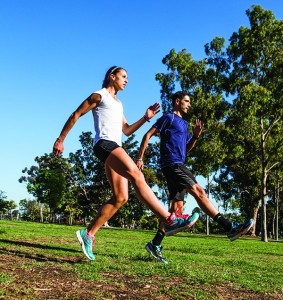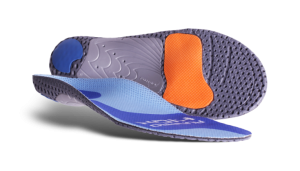We love that running is such a simple sport–you can simply lace up your shoes and GO! But there is always room for improvement, and thankfully we have pro runners Natasha, Morgan and Joanna at SMACK! Media to keep us on the pulse of the latest training tips and trends that can help us move closer to our goals, whether it’s to improve our personal best time, qualifying for the Olympics or enjoying injury-free runs!
Natasha and Morgan both lend their professional running experience to Competitor this month, sharing tips that you can implement to STEP UP your run training!
Running Form Drill: Straight-Leg Runs
Running coach and author Mario Fraioli utilizes the expert form of Natasha and husband Marco to demonstrate this key running drill to improve your form. (Photo by Scott Draper) See the full piece here.
How To Do It:
Step 1: Find a flat stretch of road, trail or grass with trustworthy footing.
Step 2: Keeping your legs straight and your ankles dorsiflexed (toes pointing upward), run forward for 50 to 75 meters, landing on your mid-foot while not allowing your feet to come too high off the ground. Keep your torso straight, swing your arms to build speed and momentum, and focus on running with a quick turnover.
Step 3: Following your first repetition, recover for 30 seconds before heading back in the opposite direction. Perform two 50-meter reps, progressing to four as you build coordination.
Do this drill twice a week after easy runs and as part of a comprehensive warm-up routine before workouts and races.
Do You Need Insoles?
Prior to SMACK! Media, Morgan worked at a specialty running store where she diligently studied and learned the intricate details of running shoe and insoles for runners of all abilities. Her recent piece featured in Competitor and Women’s Running discusses the latest insole science and technology while helping runners determine if adding a running insole is right for them. Read the full article here.
The insole market is multi-million dollar industry in the U.S., and with more options available than ever (from over-the-counter versions at your specialty running store to expensive custom orthotics), the two questions many runners ask themselves are: 1) What type of insoles are right for me and 2) Do I even need insoles at all?
What is an insole?
When you purchase running shoes, they come with a sock liner designed to enhance the comfort of that pair of shoes. Carson Caprara, the Brooks senior manager of global footwear product line management, explains, “The sock liner is the closest thing to the foot in a running shoe. Therefore, it is important to take into account the functionality of this component. Our goal is for the sock liner to enhance the overall comfort of our shoes. We mold most of our sock liners with a 3D shape that matches the natural contours of the bottom of the foot. This helps to reduce the negative space between the foot and the shoe, and cradles the heel and arch so they feel secure during the run.”
Insole myth: All insoles are designed to correct overpronation and “fix” the way you run to prevent running-related injury.
Fact: While some insoles intend to address pronation, the latest insoles designed upon current research, are built to enhance comfort, which according to the latest studies, is the key (and only proven) method for preventing running injuries! (This comes from legendary biomechanist Benno Nigg’s study from the University of Calgary.)
Who needs insoles?
Based on the latest science, anyone looking to enhance the comfort of their running shoes may want to consider trying a running-specific insole with a dynamic design to improve pressure distribution. This can range from someone dealing with an injury, to an elite athlete looking to gain a legal performance edge during workouts and races.
Who does not need insoles?
If you do not find the insoles you try to be more comfortable or comparable to your shoes with the original sock liner, then they may not be for you.
Look for: A running specific insole designed for the unique motion patterns of running (not all insoles sold to runners have this design in mind). Comfort is king (pain does NOT equal gain here). A zero mm drop is ideal so they will not interfere with your running shoe’s design.
Best bet: Visit your local specialty running retailer to try several options available and discuss how the varied designs will affect how your favorite running shoes perform.
A pro marathoner’s experience: Becky Wade, a 2:30 marathoner and Olympic hopeful, has experience wearing custom orthotics and over-the-counter insoles for running. Her focus for both ends of the insole spectrum has always been on comfort. “I don’t think that orthotics are necessary for everyone. I now wear the currexSole RUNPRO which creates a comfortable, supportive feel.”
Bottom line: The latest insole designs are lighter and more specific to running than ever! The most recent biomechanics research for running specific insoles performed at the University of Calgary and Cologne highlights that comfort is a key factor to consider when selecting an insole both for injury prevention and performance.




